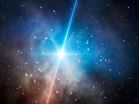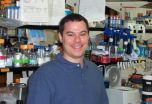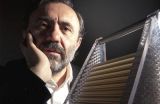(Press-News.org) Gamma-ray bursts (GRBs), fleeting events that last from less than a second to several minutes, are detected by orbiting observatories that can pick up their high energy radiation. Thirteen years ago, however, astronomers discovered a longer-lasting stream of less energetic radiation coming from these violent outbursts, which can last for weeks or even years after the initial explosion. Astronomers call this the burst's afterglow.
While all gamma-ray bursts [1] have afterglows that give off X-rays, only about half of them were found to give off visible light, with the rest remaining mysteriously dark. Some astronomers suspected that these dark afterglows could be examples of a whole new class of gamma-ray bursts, while others thought that they might all be at very great distances. Previous studies had suggested that obscuring dust between the burst and us might also explain why they were so dim.
"Studying afterglows is vital to further our understanding of the objects that become gamma-ray bursts and what they tell us about star formation in the early Universe," says the study's lead author Jochen Greiner from the Max-Planck Institute for Extraterrestrial Physics in Garching bei München, Germany.
NASA launched the Swift satellite at the end of 2004. From its orbit above the Earth's atmosphere it can detect gamma-ray bursts and immediately relay their positions to other observatories so that the afterglows could be studied. In the new study, astronomers combined Swift data with new observations made using GROND [2] — a dedicated gamma-ray burst follow-up observation instrument, which is attached to the 2.2-metre MPG/ESO telescope at La Silla in Chile. In doing so, astronomers have conclusively solved the puzzle of the missing optical afterglow.
What makes GROND exciting for the study of afterglows is its very fast response time — it can observe a burst within minutes of an alert coming from Swift using a special system called the Rapid Response Mode — and its ability to observe simultaneously through seven filters covering both the visible and near-infrared parts of the spectrum.
By combining GROND data taken through these seven filters with Swift observations, astronomers were able to accurately determine the amount of light emitted by the afterglow at widely differing wavelengths, all the way from high energy X-rays to the near-infrared. The astronomers used this information to directly measure the amount of obscuring dust that the light passed through en route to Earth. Previously, astronomers had to rely on rough estimates of the dust content [3].
The team used a range of data, including their own measurements from GROND, in addition to observations made by other large telescopes including the ESO Very Large Telescope, to estimate the distances to nearly all of the bursts in their sample. While they found that a significant proportion of bursts are dimmed to about 60 percent of the original intensity by obscuring dust, this effect is exaggerated for the very distant bursts, letting the observer see only 30 percent of the light [4]. The astronomers conclude that most dark gamma-ray bursts are therefore simply those that have had their small amount of visible light completely stripped away before it reaches us.
"Compared to many instruments on large telescopes, GROND is a low cost and relatively simple instrument, yet it has been able to conclusively resolve the mystery surrounding dark gamma-ray bursts," says Greiner.
INFORMATION:
Notes
[1] Gamma-ray bursts lasting longer than two seconds are referred to as long bursts and those with a shorter duration are known as short bursts. Long bursts, which were observed in this study, are associated with the supernova explosions of massive young stars in star-forming galaxies. Short bursts are not well understood, but are thought to originate from the merger of two compact objects such as neutron stars.
[2] The Gamma-Ray burst Optical and Near-infrared Detector (GROND) was designed and built at the Max-Planck Institute for Extraterrestrial Physics in collaboration with the Tautenburg Observatory, and has been fully operational since August 2007.
[3] Other studies relating to dark gamma-ray bursts have been released. Early this year, astronomers used the Subaru Telescope to observe a single gamma-ray burst, from which they hypothesised that dark gamma-ray bursts may indeed be a separate sub-class that form through a different mechanism, such as the merger of binary stars. In another study published last year using the Keck Telescope, astronomers studied the host galaxies of 14 dark GRBs, and based on the derived low redshifts they infer dust as the likely mechanism to create the dark bursts. In the new work reported here, 39 GRBs were studied, including nearly 20 dark bursts, and it is the only study in which no prior assumptions have been made and the amount of dust has been directly measured.
[4] Because the afterglow light of very distant bursts is redshifted due to the expansion of the Universe, the light that left the object was originally bluer than the light we detect when it gets to Earth. Since the reduction of light intensity by dust is greater for blue and ultraviolet light than for red, this means that the overall dimming effect of dust is greater for the more distant gamma-ray bursts. This is why GROND's ability to observe near-infrared radiation makes such a difference.
More information
This research is presented in a paper to appear in the journal Astronomy & Astrophysics on 16 December 2010
The team is composed of: J. Greiner (Max-Planck-Institut für extraterrestrische Physik [MPE], Germany), T. Krühler (MPE, Universe Cluster, Technische Universität München), S. Klose (Thüringer Landessternwarte, Germany), P. Afonso (MPE), C. Clemens (MPE), R. Filgas (MPE), D.H. Hartmann (Clemson University, USA), A. Küpcü Yoldaş¸ (University of Cambridge, UK), M. Nardini (MPE), F. Olivares E. (MPE), A. Rau (MPE), A. Rossi (Thüringer Landessternwarte, Germany), P. Schady (MPE), and A. Updike (Clemson University, USA)
ESO, the European Southern Observatory, is the foremost intergovernmental astronomy organisation in Europe and the world's most productive astronomical observatory. It is supported by 14 countries: Austria, Belgium, the Czech Republic, Denmark, France, Finland, Germany, Italy, the Netherlands, Portugal, Spain, Sweden, Switzerland and the United Kingdom. ESO carries out an ambitious programme focused on the design, construction and operation of powerful ground-based observing facilities enabling astronomers to make important scientific discoveries. ESO also plays a leading role in promoting and organising cooperation in astronomical research. ESO operates three unique world-class observing sites in Chile: La Silla, Paranal and Chajnantor. At Paranal, ESO operates the Very Large Telescope, the world's most advanced visible-light astronomical observatory and VISTA, the world's largest survey telescope. ESO is the European partner of a revolutionary astronomical telescope ALMA, the largest astronomical project in existence. ESO is currently planning a 42-metre European Extremely Large optical/near-infrared Telescope, the E-ELT, which will become "the world's biggest eye on the sky".
Links
Research paper in A&A: http://www.eso.org/public/archives/releases/sciencepapers/eso1049/eso1049.pdf
GROND website: http://www.mpe.mpg.de/~jcg/GROND/
Photos of the La Silla Observatory: http://www.eso.org/public/images/archive/category/lasilla/
Photo of MPG/ESO 2.2-metre telescope: http://www.eso.org/public/images/esopia00046teles/
Contacts
Jochen Greiner
Max-Planck Institute for Extraterrestrial Physics
Garching bei München, Germany
Tel: +49 89 30000 3847
Email: jcg@mpe.mpg.de
Richard Hook
ESO, La Silla, Paranal, E-ELT and Survey Telescopes Public Information Officer
Garching bei München, Germany
Tel: +49 89 3200 6655
Cell: +49 151 1537 3591
Email: rhook@eso.org
Light dawns on dark gamma-ray bursts
2010-12-17
ELSE PRESS RELEASES FROM THIS DATE:
Most Medicare stroke patients rehospitalized or dead within year
2010-12-17
Nearly two-thirds of Medicare beneficiaries discharged from hospitals after ischemic stroke die or are readmitted within one year, researchers report in Stroke: Journal of the American Heart Association.
Stroke is the second leading cause of hospital admissions among older adults in the United States, according to American Heart Association/American Stroke Association statistics. Ischemic stroke, which occurs as a result of an obstruction within a blood vessel supplying blood to the brain, accounts for 87 percent of all strokes.
Only a few contemporary studies have ...
Most Medicare stroke patients die or are rehospitalized within year after discharge
2010-12-17
A UCLA-led has study found that after leaving the hospital, nearly two-thirds of Medicare beneficiaries hospitalized for acute ischemic stroke either died or were rehospitalized within a year.
The findings point to an opportunity for more quality-of-care initiatives to improve stroke care, especially in transitioning to home, stroke rehabilitation and outpatient care.
The study, which appears online Dec. 16 in Stroke, a journal of the American Heart Association, also found that hospital mortality and readmission rates varied widely nationwide, indicating there ...
Mount Sinai researchers develop mouse model to help find how a gene mutation leads to autism
2010-12-17
Researchers from Mount Sinai School of Medicine have found that when one copy of the SHANK3 gene in mice is missing, nerve cells do not effectively communicate and do not show cellular properties associated with normal learning. This discovery may explain how mutations affecting SHANK3 may lead to autism spectrum disorders (ASDs). The research is currently published in Molecular Autism.
"We know that SHANK3 mutation plays a central, causative role in some forms of autism spectrum disorders, but wanted to learn more about how it does this," said Joseph Buxbaum, PhD, Director ...
Tools used to decipher 'histone code' may be faulty
2010-12-17
CHAPEL HILL, N.C. – The function of histones -- the proteins that enable yards of DNA to be crammed into a single cell -- depends on a number of chemical tags adorning their exterior. This sophisticated chemical syntax for packaging DNA into tight little coils or unraveling it again -- called the "histone code" -- is the latest frontier for researchers bent on understanding how genetics encodes life.
But recent research from the University of North Carolina at Chapel Hill has found a number of issues with histone antibodies, the main tools used to decipher this code, ...
A 'spin ratchet': A new electronic structure for generating spin current
2010-12-17
A research team from the Institut Català de Nanotecnologia (ICN), in Barcelona, has demonstrated a device that induces electron spin motion without net electric currents, a key step in developing the spin computers of the future. The results are published in the Dec 17 issue of the journal Science. The authors are Marius V. Costache and Sergio O. Valenzuela, an ICREA Professor who is leader of the Physics and Engineering of Nanodevices Group at ICN.
Spintronics is a branch of electronics that aims to use the electron spin rather than its charge to transport and store ...
Better spaces for older people
2010-12-17
The research project 'Older People's Use of Unfamiliar Space' (OPUS) examined the strategies used by older people to find their way in unfamiliar spaces as pedestrians and users of public transport. As part of the research, older people were shown town scenes and pedestrian routes and gave feedback on signposting, ease of navigation and general impressions. Their heart rates were measured to monitor stress levels. Participants were also taken to a town centre to walk through the same routes in person.
Initial findings show:
Signs are of limited use even in unfamiliar ...
Genome code cracked for most common form of pediatric brain cancer
2010-12-17
Scientists at the Johns Hopkins Kimmel Cancer Center have deciphered the genetic code for medulloblastoma, the most common pediatric brain cancer and a leading killer of children with cancer. The genetic "map" is believed to be the first reported of a pediatric cancer genome and is published online in the December 16 issue of Science Express.
Notably, the findings show that children with medulloblastoma have five- to tenfold fewer cancer-linked alterations in their genomes compared with their adult counterparts, the scientists say.
"These analyses clearly show that ...
CHOP experts collaborate in gene survey of childhood brain cancer; intriguing clues found
2010-12-17
Pediatric cancer researchers at The Children's Hospital of Philadelphia contributed important expertise to a new landmark study of medulloblastoma, a type of brain tumor typically found in children. The large multicenter study defines the genetic landscape of this cancer, and holds intriguing clues to gene changes on signaling pathways that may become fruitful targets for future therapies.
The most common cancerous brain tumor in children, medulloblastoma is, fortunately, rare. However, it causes significant mortality, and survivors may suffer serious long-term side effects ...
Iowa State, Ames Lab physicist developing, improving designer optical materials
2010-12-17
AMES, Iowa – Advancements in fabrication technologies may lead to superlenses and other designer optical materials, according to an Iowa State University and Ames Laboratory physicist.
In an article titled "Improving Metamaterials" published in the Perspectives section of the Dec. 17 issue of the journal Science, Costas Soukoulis and Martin Wegener write about the man-made materials designed to deliver certain properties not found in nature.
Soukoulis is an Iowa State University Distinguished Professor and Frances M. Craig Professor of Physics and Astronomy and a senior ...
Liver cancer in cirrhotic patients effectively treated with radiofrequency ablation
2010-12-17
Researchers from Italy determined that radiofrequency ablation (RFA) is a safe and effective therapy for managing hepatocellular carcinoma (HCC) in cirrhotic patients. The high repeatability of RFA is advantageous in controlling recurrences of cancerous tumors in the liver. Results of this 10-year retrospective study are available in the January 2011 issue of Hepatology, a journal published by Wiley-Blackwell on behalf of the American Association for the Study of Liver Diseases (AASLD).
HCC is the third leading cause of death from cancer worldwide and according to the ...


